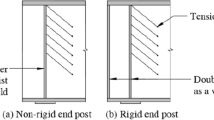Abstract
The determination of the concentrated load performance of floor panels from concentrated load tests is useful in their load capacity and stiffness ratings by floor-panel manufacturers. Concentrated load tests of 18-mm thick one-way spanning simply supported oriented strand board (OSB) panels with ratios of span to thickness of 16.7, 25.0 and 33.3 have been carried out in order to characterise the trends in the stiffness, load capacity and type of failure of the panels. The panels exhibited punching shear-type failures. Linear equations have been fitted to the graphs of stiffness versus ratio of thickness to span squared and to the load capacity versus ratio of thickness to span. Linear relationships between stiffness versus ratio of thickness to span squared and load capacity versus ratio of thickness to span are predicted for continuous and fixed-edge panels. In the light of the extensive use of computerised design programmes and the preference for formulae in new design Standards and Codes, the determination and publication of these concentrated load capacity and stiffness formulae for floor panels should be invaluable to designers.
Résumé
La détermination des performances en charge concentrée de panneaux de planchers est utile pour l'évaluation de leur capacité de charge et de leur rigidité par les fabriquants de planchers. Des essais en charge concentrée sur des panneaux de copeaux orientés (OSB) de 18 mm d'épaisseur, de portée unidirectionnelle, simplement supportés, avec des rapports épaisseur/portée de 16,7, 25,0 et 33,3 ont été réalisés dans le but de caractériser les tendances relatives à la rigidité, à la capacité de charge et au type de rupture des panneaux. Ces panneaux ont montré des ruptures de type cisaillement par perforation. Des équations linéaires ont été ajustées aux graphiques décrivant la rigidité contre le rapport épaisseur/portée. Des relations linéaires entre la rigidité contre le rapport épaisseur/portée au carré et la capacité de charge contre le rapport épaisseur/portée ont été prévues pour des panneaux continus et à bonds fixéx. À la lumière d'un usage répandu de programmes d'études informatisés et de la préférence pour des formules au sein de nouveaux codes et nomes, la détermination et la publication de ces formules relatives à la capacité de charge concentrée et à la rigidité pour les planchers devraient être d'une valeur inestimable pour les concepteurs.
Similar content being viewed by others
References
American Society for Testing and Materials, ‘ASTM E661-88 Standard test method for performance of wood and wood-based floor and roof sheathing under concentrated static and impact loads’, American Society for Testing and Materials, Philadelphia, PA., USA (1988).
European Committee for Standardisation, ‘prEN 1195 Timber Structures—Test Methods—The performance of structural floor decking’, European Committee for Standardisation, Brussels, Belgium (1997).
Soothill, C., ‘Concentrated load capacity (punching shear) of wood chipboard—Part 2: Assessment of the influence of bending on the resistance of flooring chipboard to gradually applied concentrated loads’, Research Report 2/84, Timber Research and Development Association, High Wycombe, Bucks., UK (1984).
Kearley, V. C. and Carruthers, J. G., ‘Assessment of the distribution and effects of concentrated loads applied to wood-based sheet materials’, Report No. RD91204, Timber Research and Development Association, High Wycombe, Bucks., UK (1991).
Thomas, W. H., ‘Bending behaviour of OSB decking under concentrated load’, PhD thesis, University of Surrey, Guildford, Surrey, UK (1996).
American Plywood Association, ‘Test methods and performance requirements for floor and roof sheathing’, Research Report 135C, American Plywood Association, Tacoma, Washington, USA (1976).
European Committee for Standardisation, ‘EN 789 Timber structures—Testing of wood panels for the determination of mechanical properties for structural purposes’, European Committee for Standardisation, Brussels, Belgium (1992).
Bares, R., ‘Tables for the analysis of plates, slabs and diaphragms based on the elastic theory’, (Bauverlag GmbH, Wiesbaden and Berlin, Germany, 1971).
Cope, R. J. and Clark, L. A., ‘Concrete slabs: Analysis and design’, (Elsevier Applied Science Publishers Ltd, Essex, England, 1984).
Author information
Authors and Affiliations
Rights and permissions
About this article
Cite this article
Thomas, W.H. Failure modes and trend curves for load capacity and stiffness of OSB panels subjected to concentrated load. Mat. Struct. 36, 68–72 (2003). https://doi.org/10.1007/BF02481573
Received:
Accepted:
Published:
Issue Date:
DOI: https://doi.org/10.1007/BF02481573




